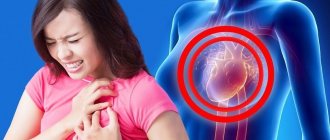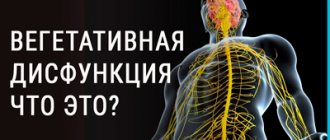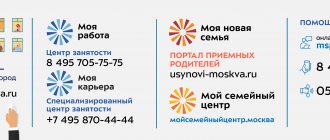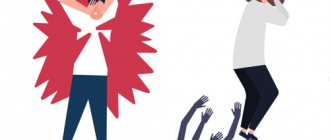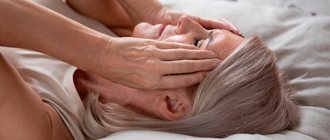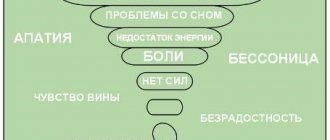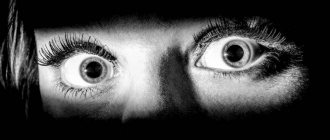The coronavirus epidemic that has befallen us has turned out to be dangerous in its consequences. Doctors name dozens of serious consequences, including lung disease, heart disease, liver and kidney damage. Coronavirus also causes a serious blow to the nervous system. Experts say that frequent symptoms of those who have been ill are panic attacks - sudden attacks that, if repeated frequently, can even cause a person’s death.
What are panic attacks? And how to deal with them?
How to recognize?
A sudden feeling of anxiety and fear of death, a feeling as if the heart is jumping out of the chest, lack of air and internal trembling, nausea, vomiting, and most importantly - all this for no apparent reason. This is how a panic attack manifests itself.
“We were at a friend’s dacha, and at night I woke up abruptly with the feeling that my heart was gurgling. It's hard to describe in words. There was great fear, I was trembling all over, it seemed that my end had come. I opened the window, began to breathe and make promises to the whole world - I will quit smoking, drinking, I will start running, just, Lord, let me go.”
Panic attacks often begin suddenly, and those experiencing them for the first time may think it is a heart attack due to rapid heartbeat and chest pain. They can also be similar to anxiety attacks, but experts emphasize that with panic attacks, the main psychological symptom is an intense fear of death.
“It’s like they’re killing me,” shares one user on the social network.
The duration of the attack may be only a few minutes, in other cases it lasts several hours. But on average its duration is 20-30 minutes.
Many admit that because of this they develop many phobias - they are afraid to go out in public, ride the subway, ride in the elevator, fly on an airplane, walk up the stairs. People are beginning to fear confined spaces where there will be no access to help...
VSD, Panic attacks
Anonymous user
December 7, 2020
Good afternoon. I really ask for your help. In August I got sick with Covid. 10 days in the hospital. TYPE against the background of coronavirus. After discharge, my legs began to go numb below the knees. Now 4 months have passed since the illness. And I still feel bad. Numbness in legs does not go away. I feel dizzy at times. Sometimes it hurts. Periodically, the arms go numb from the shoulder to the hand. Not completely, but in places. Slight weakness. Tachycardia in motion. There were strong PAs. But I was able to drown them out. And so on December 5 (2 days ago) I went for an MRI. They told me to check my head + arteries + veins. Let me say in advance that I am wildly afraid of confined spaces. But it had to be done. At the end of the study I felt sick. I felt very dizzy, I had the feeling that I was falling somewhere, and my right hand began to go numb. I called the doctor. He said that we need to wait 3 minutes. Somehow I suffered. They pulled me out of the device, and I could barely stand, I was shaking so much. At home I continued to shake, my blood pressure rose a little. At 12 am I fell asleep. And I woke up with a sore throat (I had a cold) and a headache. I took a pill. After about 30 minutes she helped and I decided to go to bed. But as soon as I lay down, my right arm began to go numb and then it hit me. Wild fear. Panic. The pulse jumped to 136. It became difficult to breathe. My head started to spin. My blood pressure jumped from 143 to 93. I drank kapoten and glycine under my tongue. Let go. But after 10 minutes it came again. I called an ambulance. While I was waiting, they let me go again. Blood pressure and pulse returned to normal. But then it covered me again. The ambulance has arrived. With them, I was once again covered and released. They said that the ECG was normal, the pulse pressure was normal. That I’m having a panic attack due to fear and stress experienced during the MRI. They told me to go to a neurologist. Treat nerves and neck. Since I was lying in the MRI machine, I was very uncomfortable and all the tension was on my neck and head. She held the waistband of her trousers with her hands. And when she let go, my fingers were burgundy. The ambulance left and told me to go to bed. Somehow by 6:30 am I fell asleep. Yesterday I walked around broken all day. I wanted to go to bed. But as soon as I closed my eyes, I immediately felt unwell. It felt like I was lying in this MRI machine. I opened my eyes and everything passed. I slept last night. Fine. Everything is more or less good. And then, out of the blue, I sat and my head suddenly seemed to feel hot, it became somehow unpleasant and a wild fear appeared in it. But I pulled myself together and in less than a minute it passed. About an hour later it happened again. I went to play on the phone. And again the heat in the head. Unexplained sensations in the head. And wild fear. Again, I tried to calm myself down. In a minute it was all over. At the same time, my hands and feet are icy (even under the blanket). Blood pressure is 124 over 84. Before going to the MRI it was usually 108/115 over 77/82. I also noticed that if I now read something bad, I immediately feel unwell. The questions are: 1. What’s wrong with me? Was it after the intense stress from the MRI that these panic attacks appeared? And it’s these sensations that frighten me, like heat and it’s unclear what’s in my head (this had never happened before the MRI procedure). 2. Can PA occur several times a day out of nowhere or from the slightest stress or anxiety? 3. Is my MRI result very bad? 4. How can I cope with fear? I sit and now I’m afraid every minute that this terrible feeling in my head might come over me again. ((( PS I am adding examinations: MRI photo Ophthalmologist photo ENMG of the legs - normal Ultrasound of the arms and legs - arteries are normal. The veins in both the arms and legs are dilated. I take: Eliquis 2.5 mg - 2 times, enalapril 5 mg - in the morning, vitamin D, Picamilon 50 mg - morning and evening.
The question is closed
VSD
panic attacks
Where does it come from?
A panic attack always occurs against a background of general nervous tension.
Firstly, these are internal problems, self-doubt, fear of loneliness, various addictions (alcohol, drugs, medications), life circumstances.
Secondly, the so-called interpersonal sphere - problems with loved ones, sexual partners, wives, husbands. And also – unjustified expectations, resentment, disappointment in a partner and much more.
And finally, the professional sphere – problems at work, preoccupation with one’s career, success, workaholism.
Experts say that women suffer from panic disorders more often than men. Moreover, the risk of getting sick depends not only on gender, but also on age. Most often, the disorder develops in so-called “young adults” – 20-25 year olds.
The characteristics of the nervous system also influence. Those who have a tendency to easily change the “mode” of the autonomic nervous system are more susceptible to panic attacks. Such people quickly blush, sweat, they often feel dizzy from excitement, stuffiness, overwork, and their heart rate easily increases during physical and emotional stress.
Personality characteristics of a person also play a significant role. Thus, in anxious people, panic disorder is more common than the average population. However, anxiety is not a direct path to panic attacks. We are talking only about predisposition.
There is also a certain “nepotism” here. If there are those in the family who suffer from panic attacks, then the risk of getting sick in other family members is higher.
Panic disorder. Part 1. A disease that doesn’t exist?
All people who suffer from panic attacks have that very first time where it all begins. One fine, or perhaps not so good, day, filled with anxieties and worries, they experience a sharp change in their condition. They experience heart palpitations, trembling throughout the body, rapid breathing, and dry mouth. And most importantly, the horror of death rolls over them...
This horror paralyzes some, while others want to rush around in search of immediate help. And then the ambulance arrives, the doctors take an ECG, examine the patient and issue a conclusion: “Everything is fine with you. It's just nerves." It would seem that you can breathe out and live your old life. But it was not there. The story is just beginning...
What happened?
Usually this condition occurs because the person is very frightened by something. In this case, he was afraid of a sudden change in the functioning of his body. It began to seem to him that he was sick with something, he had a heart attack or stroke. But the cause of this condition is not related to diseases of the internal organs, but is of a mental nature. It is the nervous system that changes the nature of its work and causes all this terrible storm inside. This state takes a person by surprise. For this reason, in this case they talk about a panic attack.
Manifestations of attacks can be varied. They can be divided into two large groups: symptoms from internal organs (somatic) and mental manifestations.
Somatic symptoms
Most often, during an attack, a person experiences a feeling of compression in the heart area and palpitations. This can be the most frightening thing, because in the understanding of many people, these symptoms are signs of a heart attack.
But during a panic attack, the feeling of increased heartbeat is subjective. The patient feels as if the heart is beating at an accelerated pace. In fact, the pulse may remain within normal limits.
In addition to unpleasant heart sensations, a person in a state of panic attack experiences a feeling of constriction in the chest. It seems to him that he is suffocating and does not have enough air. He trembles, experiences hot or cold flashes, and feels dizzy.
Sometimes this can be accompanied by abdominal pain, nausea and even vomiting.
Mental symptoms
In such a state it is difficult to remain calm. If your body does this, how can you not worry? A person develops a sharp fear of death. He is worried that he will not be able to cope with his condition and that he will not be able to receive timely help.
People start rushing around, trying to find someone who could help, or, on the contrary, they huddle in a corner and are afraid to move. After all, any movement can cause a subjective feeling of worsening of the condition.
How the disorder is formed
For some people, this condition occurs once or twice in their lives and never happens again. They occasionally recall what happened with hostility, but this does not have much impact on them.
Others, after the first time, are constantly faced with panic. The threat of an unexpected change of state hangs over them like a sword of Damocles. People begin to fear that the attack may recur. As a result, panic attacks begin to “overgrow” with fears.
People try to change their behavior and lifestyle to reduce the risk of an attack. Their condition is already determined not only by the attacks, but also by the fears associated with them, and by various behavioral tricks that are designed to deceive the disease. Gradually, a person's personality and character change. Based on panic attacks, a more severe condition develops, which is called “panic disorder”.
Physiology of the disease
What causes this disorder? The nervous system, weakened by stress, is “to blame” for everything.
The first time symptoms appear is most often due to fatigue, overheating or lack of sleep. All this is superimposed on some long-standing stress. Stress hormones are released into the blood, primarily adrenaline. But this is not enough for the development of the disorder.
But when this storm falls on a person in an inappropriate situation, where he feels helpless (he was riding in an elevator, was in an unfamiliar place where he didn’t know anyone, found himself locked in a room), then he can become truly scared. The patient is overcome by fear not only because of the unpleasant symptoms, but also by the horror that he will die here alone and no one will be able to help him.
This fear remains forever in the memory. And when a person finds himself in a similar situation, riding alone in the same elevator or finding himself in a stuffy room, his brain can automatically remember everything and trigger panic again. Adrenaline is again released into the blood, which again causes heart palpitations, rapid breathing, trembling, and a feeling of fear. Neither the heart, nor the blood vessels, nor the lungs are damaged, it’s just that adrenaline makes them work at the limit of their strength.
Who's at risk
Not everyone is affected by the disorder in the same way. Women suffer from panic disorders more often than men. Moreover, the risk of getting sick depends not only on gender, but also on age. Most often, the disorder develops in so-called “young adults”—20–25 year olds.
The characteristics of the nervous system also influence. Those who have a tendency to easily change the “mode” of the autonomic nervous system are more susceptible to panic attacks. Such people quickly blush, sweat, they often feel dizzy from excitement, stuffiness, overwork, and their heart rate easily increases during physical and emotional stress.
Personality characteristics of a person also play a significant role. Thus, in anxious people, panic disorder is more common than the average population. However, it is worth noting that anxiety is not a direct path to panic attacks. It's just a matter of predisposition.
There is also a certain “nepotism” here. If there are those in the family who suffer from panic attacks, then the risk of getting sick in other family members is higher. Is this disorder hereditary? It has not yet been reliably established. Genetic characteristics may be to blame here, or perhaps the “infectious example” of one of the family members plays a role. Children can observe their parents' behavior and unconsciously copy it.
Panic attacks can recur for many months or even years. Patients feel tied hand and foot by their problem. Is there a way out of this “vicious circle”? I will tell you in my next article.
Natalia Stilson
Photo thinkstockphotos.com
How to treat?
If attacks occur more than two or three times a month, you should consider visiting a psychotherapist. This visit will not have any consequences in the form of registration.
A combination of psychotherapy and medication is used to treat panic disorder. In the first stages, the doctor usually prescribes sedatives and antidepressants that reduce anxiety and calm the nervous system. Such medications have a cumulative effect, the effect begins on the third or fourth day of use, the result lasts for more than seven days.
But the main work begins later, with a psychotherapist. The main cause of panic disorder is psychological conflicts that do not find a way out. And they are unconscious, and therefore cannot be resolved by a person for some reason. That’s when the psychotherapist helps the person bring the conflict to the surface and work through the situation.
Interaction of phenibut with drugs - consequences of taking
Addiction
Medicine denies the narcotic effect of the drug, but if the dosage is exceeded and long-term use, phenibut causes addiction.
The drug does not cause chemical addiction, but when using the tablets for 6-8 weeks, the active substance is integrated into the patient’s metabolism. Therefore, with a sharp refusal, withdrawal syndrome occurs - the lack of medication negatively affects psychophysical health.
Some patients experience pleasure from taking the drug, and there is a desire to get the effect again. Psychological dependence may occur.
Narcologists do not recommend abruptly stopping medication. By the end of the course of treatment, the dose is reduced to the minimum (20 mg) within 1-2 weeks.
Overdose
For addiction, patients take phenibut in higher dosages. There is a possibility of poisoning the body. An overdose of phenibut causes:
- tachycardia
- nausea, vomiting
- motor excitement
- headache
- drowsiness or insomnia
Consequences
The consequences of an overdose of pills affect the entire body:
- liver failure
- renal failure
- stomach bleeding
- liver tissue damage
Treatment
Treatment for phenibut drug addiction is carried out by medical professionals. It takes place in 2 stages:
- First aid for overdose
- Addiction treatment
First aid is carried out in a hospital or at home. The patient receives help at home, if the addiction is not identified, the drug is taken accidentally. Inpatient recovery is required for addiction or visible complications (allergies, the patient cannot be controlled, there is blood in the discharge). For first aid:
- Stop taking phenibut
- The stomach is washed
- Adsorbents accepted
- Laxatives are taken
Treatment for drug addiction in a hospital involves detoxification. After normalization of the patient’s condition, he receives symptomatic therapy, which is combined with psychological influence. The patient is considered healthy when organs recover after taking phenibut and are free from withdrawal symptoms. Treatment lasts 4-8 weeks.
Hallucinations when using the drug
In its pure form, Phenibut is not capable of causing hallucinations, especially if taken within recommended doses. However, in rare cases, psychoactive effects with the active participation of the person himself in hallucinations are possible. Somewhat less often, “voices” appear with which the drug addict has long conversations. But to obtain this effect, a dosage of the substance is used many times greater than what is needed for treatment. Moreover, this picture is not observed for everyone. Obviously, this depends on the characteristics of the organism.
More often, hallucinations can be provoked when using Phenibut with drugs. In this case, the drug only enhances euphoria, but can also increase the likelihood of various visions. And when the drug is discontinued, this phenomenon develops as one of the withdrawal symptoms.
Compatibility of Haloperidol with Phenibut
Neuroleptics are powerful antipsychotic drugs, the prescription of which requires serious reasons. Treatment with Haloperidol is quite difficult for patients to tolerate, and therefore doctors are trying to resort to more modern analogues. It is not recommended to add a drug with unproven effectiveness and a poorly studied safety profile to the therapeutic regimen.
Interaction
Doses of medications are selected individually according to the severity of the underlying disease. However, susceptibility to pharmacological substances varies from person to person. In addition, it is necessary to take into account the presence of concomitant pathology and the safety of internal organs.
Haloperidol with Phenibut is a dangerous combination, because the latter significantly enhances and prolongs the effect of antipsychotics. When using aminophenylbutyric acid in combination with other central nervous system depressants (hypnotics, narcotic analgesics), a review of the dosages of all medications is required. Patients should be under inpatient medical supervision in case of adverse reactions.
Consequences of combined use
All psychotropics are used exclusively within the prescribed therapeutic regimen, usually in short courses. If drug doses have not been adjusted, the following consequences should be expected:
- increased risk of extrapyramidal disorders - tremors of the limbs (tremor), tics, parkinsonism, uncontrolled motor activity, impaired muscle tone;
- exacerbation of psychopathological symptoms of the underlying disease;
- the appearance of thoughts of suicide, the development of depression;
- anxiety, fear, tendency to impulsive-aggressive reactions;
- headache;
- sleep disorders;
- paradoxical arousal – agitation, psychosis;
- allergic reactions;
- a drop in blood pressure accompanied by transient episodes of impaired consciousness;
- deterioration of cognitive-intellectual (mental) activity;
- decreased reaction speed;
- increased side effects of Haloperidol on the endocrine system - erectile dysfunction, decreased libido, menstrual irregularities, infertility, gynecomastia (breast enlargement in men);
- increased risk of cardiovascular diseases, osteoporosis, diabetes, obesity.
- gastrointestinal disorders - nausea, diarrhea/constipation, abdominal pain, dry mouth.
How to cope with an attack?
It's difficult, but possible.
Slow breathing helps to cope with a rapid heartbeat and shallow breathing, which are both symptoms of a panic attack and its provocateurs. By breathing slowly, you send a signal to your brain to calm down. This is one of the most effective ways to stop a panic attack.
Focus on your breathing. Inhale for one-two-three-four, hold your breath for one second, exhale for one-two-three-four.
Choose one object that is close and direct all your attention to it. Mentally describe the color, size, shape, how it feels, how it moves or can move. For example, you can watch the hand of a clock move.
It is also important to learn to “devalue your panic.” When you feel fear rolling over you in waves, relax and accept this state. Don't resist. Meet panic with the words “Well, let it be!”, “Yes, I feel it, but I don’t care,” “And anyway, why is it so weak?”, “Is that all?” Take the onset of panic calmly. This will prevent your body from releasing adrenaline. And when you stop the attacks several times in this way, they will eventually disappear completely.
